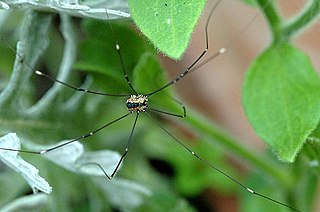Related Research Articles

Adiantum, the maidenhair fern, is a genus of about 250 species of ferns in the subfamily Vittarioideae of the family Pteridaceae, though some researchers place it in its own family, Adiantaceae. The genus name comes from Greek, meaning "unwetted", referring to the fronds' ability to shed water without becoming wet.

Catechin is a flavan-3-ol, a type of natural phenol and antioxidant. It is a plant secondary metabolite. It belongs to the group of flavan-3-ols, part of the chemical family of flavonoids.

Pennisetum is a widespread genus of plants in the grass family, native to tropical and warm temperate regions of the world. They are known commonly as fountaingrasses. Pennisetum is considered a synonym of Cenchrus in Kew's Plants of the World Online.

Chaetomium is a genus of fungi in the Chaetomiaceae family. It is a dematiaceous (dark-walled) mold normally found in soil, air, cellulose and plant debris. According to the Dictionary of the Fungi, there are about 95 species in the widespread genus.

The Calosoma sycophanta or forest caterpillar hunter is a ground beetle belonging to the family Carabidae.

Leiobunum is a genus of the harvestman family Sclerosomatidae with more than a hundred described species. Contrary to popular belief, they are not spiders, although they share a resemblance. They are arachnids, in the order Opiliones, harvestmen. Species in Leiobunum tend to have relatively long legs compared with other harvestmen, and some species are gregarious.

Diacamma is a genus of queenless ants sometimes known as Asian bullet ants, belonging to the subfamily Ponerinae. It is distributed from India to Australia and contains about 24 species.

Bulbophyllum cupreum is a species of orchid in the genus Bulbophyllum.
Steinchisma is a genus of plants in the grass family, native to the Americas but a few of them naturalized in Africa.
Chaetomium cupreum is a fungus in the family, Chaetomiaceae. It is able to decay in manufactured cellulosic materials, and is known to antagonize a wide range of soil microorganisms. This species is component of the biocontrol agent, Ketomium, a commercial biofungicide. It has also been investigated for use in the production of natural dyes. Chaetomium cupreum is mesophilic and known to occur in harsh environments and can rapidly colonize organic substrates in soil. Laboratory cultures of C. cupreum can be propagated on a range of common growth media including potato dextrose at ambient or higher than ambient temperature producing cottony white colonies with a reddish reverse.
Agonum cupreum is a species of ground beetle from the subfamily Platyninae. It was described by Dejean in 1828 and is found in Duluth, Minnesota and Canada.
Sybaguasu is a genus of longhorn beetles of the subfamily Lamiinae, containing the following species:
Sybaguasu anemum is a species of beetle in the family Cerambycidae. It was described by Martins and Galileo in 2004. It is known from Panama.
Sybaguasu cornutum is a species of beetle in the family Cerambycidae. It was described by Galileo and Martins in 2005. It is known from Brazil.
Sybaguasu longipennis is a species of beetle in the family Cerambycidae. It was described by Henry Walter Bates in 1881. It is known from Ecuador.
Sybaguasu thoracicum is a species of beetle in the family Cerambycidae. It was described by Olivier in 1795. It is known from Brazil and French Guiana.
Sybaguasu titingum is a species of beetle in the family Cerambycidae. It was described by Martins and Galileo in 1991. It is known from Peru.
References
- ↑ BioLib.cz - Sybaguasu cupreum. Retrieved on 8 September 2014.
| This Hemilophini article is a stub. You can help Wikipedia by expanding it. |